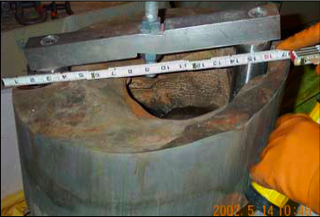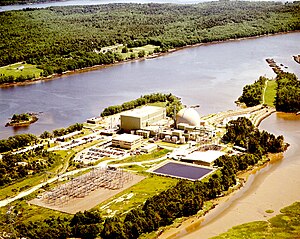
The Nuclear Regulatory Commission (NRC) is an independent agency of the United States government tasked with protecting public health and safety related to nuclear energy. Established by the Energy Reorganization Act of 1974, the NRC began operations on January 19, 1975, as one of two successor agencies to the United States Atomic Energy Commission. Its functions include overseeing reactor safety and security, administering reactor licensing and renewal, licensing radioactive materials, radionuclide safety, and managing the storage, security, recycling, and disposal of spent fuel.

Vermont Yankee was an electricity generating nuclear power plant, located in the town of Vernon, Vermont, in the northeastern United States. It generated 620 megawatts (MWe) of electricity at full power. The plant was a boiling water reactor (BWR), designed by General Electric. It operated from 1972 until December 29, 2014, when its owner Entergy shut down the plant. In 2008, the plant provided 71.8% of all electricity generated within Vermont, amounting to 35% of Vermont's electricity consumption. The plant is on the Connecticut River, upstream of the Vernon, Vermont Hydroelectric Dam and used the reservoir pool for its cooling water.

The San Onofre Nuclear Generating Station (SONGS) is a permanently closed nuclear power plant located south of San Clemente, California, on the Pacific coast, in Nuclear Regulatory Commission Region IV. The plant was shut down in 2013 after defects were found in replacement steam generators; it is currently in the process of decommissioning. The 2.2 GW of electricity supply lost when the plant shut down was replaced with 1.8 GW of new natural-gas fired power plants and 250 MW of energy storage projects.

Peach Bottom Atomic Power Station, a nuclear power plant, is located 50 miles (80 km) southeast of Harrisburg in Peach Bottom Township, York County, Pennsylvania, on the Susquehanna River three miles north of the Maryland border.

The Prairie Island Nuclear Generating Plant is an electricity-generating facility located in Red Wing, Minnesota, along the Mississippi River, and adjacent to the Prairie Island Indian Community reservation.

The South Texas Project Electric Generating Station, is a nuclear power station southwest of Bay City, Texas, United States. STP occupies a 12,200-acre (4,900 ha) site west of the Colorado River about 90 miles (140 km) southwest of Houston. It consists of two Westinghouse Pressurized Water Reactors and is cooled by a 7,000-acre (2,800 ha) reservoir, which eliminates the need for cooling towers.

The Shippingport Atomic Power Station was the world's first full-scale atomic electric power plant devoted exclusively to peacetime uses. It was located near the present-day Beaver Valley Nuclear Generating Station on the Ohio River in Beaver County, Pennsylvania, United States, about 25 miles (40 km) from Pittsburgh.

Nuclear power in the United States is provided by 92 commercial reactors with a net capacity of 94.7 gigawatts (GW), with 61 pressurized water reactors and 31 boiling water reactors. In 2019, they produced a total of 809.41 terawatt-hours of electricity, which accounted for 20% of the nation's total electric energy generation. In 2018, nuclear comprised nearly 50 percent of US emission-free energy generation.

Nuclear safety is defined by the International Atomic Energy Agency (IAEA) as "The achievement of proper operating conditions, prevention of accidents or mitigation of accident consequences, resulting in protection of workers, the public and the environment from undue radiation hazards". The IAEA defines nuclear security as "The prevention and detection of and response to, theft, sabotage, unauthorized access, illegal transfer or other malicious acts involving nuclear materials, other radioactive substances or their associated facilities".

Yankee Rowe Nuclear Power Station (decommissioned) was a nuclear power plant in Rowe, Massachusetts, that operated from 1960 to 1992. The 185-megawatt electric pressurized-water plant, located on the Deerfield River in the town of Rowe in western Massachusetts, right on the border of Readsboro, Vermont, permanently shut down on February 26, 1992, after more than 31 years of producing electricity for New England electric consumers.

Nuclear decommissioning is the process whereby a nuclear facility is dismantled to the point that it no longer requires measures for radiation protection. The presence of radioactive material necessitates processes that are potentially occupationally hazardous, expensive, time-intensive, and present environmental risks that must be addressed to ensure radioactive materials are either transported elsewhere for storage or stored on-site in a safe manner. The challenge in nuclear decommissioning is not just technical, but also economical and social.

La Crosse Boiling Water Reactor (LACBWR) is a retired Boiling Water Reactor (BWR) nuclear power plant located near La Crosse, Wisconsin in the small village of Genoa, in Vernon County, Wisconsin, approximately 17 miles south of La Crosse along the Mississippi River. It was located directly adjacent to the coal-fired Genoa Generating Station. The site is owned and was operated by the Dairyland Power Cooperative (DPC).
Nuclear history of the United States describes the history of nuclear affairs in the United States whether civilian or military.

Nuclear safety in the United States is governed by federal regulations issued by the Nuclear Regulatory Commission (NRC). The NRC regulates all nuclear plants and materials in the United States except for nuclear plants and materials controlled by the U.S. government, as well those powering naval vessels.

The anti-nuclear movement in the United States consists of more than 80 anti-nuclear groups that oppose nuclear power, nuclear weapons, and/or uranium mining. These have included the Abalone Alliance, Clamshell Alliance, Committee for Nuclear Responsibility, Nevada Desert Experience, Nuclear Information and Resource Service, Physicians for Social Responsibility, Plowshares Movement, Women Strike for Peace, and Women's International League for Peace and Freedom. Some fringe aspects of the anti-nuclear movement have delayed construction or halted commitments to build some new nuclear plants, and have pressured the Nuclear Regulatory Commission to enforce and strengthen the safety regulations for nuclear power plants. Most groups in the movement focus on nuclear weapons.
Nuclear entombment is a method of nuclear decommissioning in which radioactive contaminants are encased in a structurally long-lived material, such as concrete. This prevents radioactive material and other contaminated substances from being exposed to human activity and the environment. Entombment is usually applied to nuclear reactors, but also some nuclear test sites. Nuclear entombment is the least used of three methods for decommissioning nuclear power plants, the others being dismantling and safe enclosure. The use of nuclear entombment is more practical for larger nuclear power plants that are in need of both long and short term burials, as well as for power plants which seek to terminate their facility licenses. Entombment is used on a case by case basis because of its major commitment with years of surveillance and complexity until the radioactivity is no longer a major concern, permitting decommissioning and ultimate unrestricted release of the property. Considerations such as financial backing and the availability of technical know-how are also major factors.

Between 2007 and 2009, 13 companies applied to the Nuclear Regulatory Commission (NRC) for construction and operating licenses to build 31 new nuclear power reactors in the United States. However, the case for widespread nuclear plant construction has been hampered due to inexpensive natural gas, slow electricity demand growth in a weak US economy, lack of financing, and safety concerns following the Fukushima nuclear disaster in 2011.
In Pacific Gas & Electric Co. v. State Energy Resources Conservation & Development Commission, 461 U.S. 190 (1983), the United States Supreme Court held that a state statute regulating economic aspects of nuclear generating plants was not preempted by the federal Atomic Energy Act of 1954. The case provides a framework that has guided other cases involving preemption of federal authority.

The United States Government Accountability Office reported more than 150 incidents from 2001 to 2006 of nuclear plants not performing within acceptable safety guidelines. According to a 2010 survey of energy accidents, there have been at least 56 accidents at nuclear reactors in the United States. The most serious of these was the Three Mile Island accident in 1979. Davis-Besse Nuclear Power Plant has been the source of two of the top five most dangerous nuclear incidents in the United States since 1979. Relatively few accidents have involved fatalities.

The nuclear energy policy of the United States began in 1954 and continued with the ongoing building of nuclear power plants, the enactment of numerous pieces of legislation such as the Energy Reorganization Act of 1974, and the implementation of countless policies which have guided the Nuclear Regulatory Commission and the Department of Energy in the regulation and growth of nuclear energy companies. This includes, but is not limited to, regulations of nuclear facilities, waste storage, decommissioning of weapons-grade materials, uranium mining, and funding for nuclear companies, along with an increase in power plant building. Both legislation and bureaucratic regulations of nuclear energy in the United States have been shaped by scientific research, private industries' wishes, and public opinion, which has shifted over time and as a result of different nuclear disasters.
















